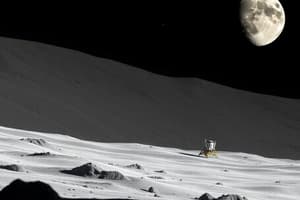Podcast
Questions and Answers
What key property of basalt made it suitable for creating the Chinese flag planted on the Moon by the Chang'e 6 lander?
What key property of basalt made it suitable for creating the Chinese flag planted on the Moon by the Chang'e 6 lander?
- Basalt's low density ensures that the flag remains lightweight, minimizing the overall mass of the Chang'e 6 mission.
- Basalt's high iron content allows it to be magnetized, enabling the flag to stand upright in the Moon's low-gravity environment.
- Basalt's vibrant color provides a striking contrast against the lunar surface, enhancing visibility for future missions.
- Basalt can be processed into high-performance inorganic fiber, making it a durable material for withstanding the harsh lunar conditions. (correct)
Why is the South Pole-Aitken (SPA) basin on the Moon's far side of significant scientific interest?
Why is the South Pole-Aitken (SPA) basin on the Moon's far side of significant scientific interest?
- It is believed to contain large deposits of rare Earth elements, which are critical for advanced technology manufacturing.
- Its smooth, flat surface makes it an ideal landing site for spacecraft, reducing the risk of damage during landing.
- Its location near the lunar equator provides optimal conditions for solar energy collection, making it ideal for future lunar bases.
- As one of the largest and oldest impact craters in the Solar System, it may hold clues about the early history and evolution of the Moon and the solar system. (correct)
What is the primary reason scientists are interested in analyzing the samples retrieved from the Moon's far side by the Chang'e 6 mission?
What is the primary reason scientists are interested in analyzing the samples retrieved from the Moon's far side by the Chang'e 6 mission?
- To determine the economic viability of mining rare minerals found exclusively on the far side.
- To understand the differences between the near and far sides of the Moon and gain insights into the early history of the solar system. (correct)
- To assess the level of radiation exposure on the far side, crucial for planning long-term human missions.
- To study the potential for terraforming the far side of the Moon to make it habitable for future human colonies.
Consider the entire Chang'e 6 mission from launch to sample retrieval. What innovative approach was most crucial to mission success?
Consider the entire Chang'e 6 mission from launch to sample retrieval. What innovative approach was most crucial to mission success?
If future missions to the Moon's far side aim to establish a permanent research base, which factor, revealed by the Chang'e 6 mission, would be most important to consider during the planning phase?
If future missions to the Moon's far side aim to establish a permanent research base, which factor, revealed by the Chang'e 6 mission, would be most important to consider during the planning phase?
The Chang'e 6 mission successfully retrieved approximately two kilograms of lunar material. What logistical challenge in future lunar sample return missions would be amplified if a mission aimed to bring back significantly larger quantities, such as 100 kilograms or more?
The Chang'e 6 mission successfully retrieved approximately two kilograms of lunar material. What logistical challenge in future lunar sample return missions would be amplified if a mission aimed to bring back significantly larger quantities, such as 100 kilograms or more?
Assume a hypothetical scenario where analysis of the Chang'e 6 samples reveals evidence of past volcanic activity on the Moon's far side that is chemically distinct from volcanic rocks found on the near side. How might this discovery reshape existing scientific models of lunar evolution?
Assume a hypothetical scenario where analysis of the Chang'e 6 samples reveals evidence of past volcanic activity on the Moon's far side that is chemically distinct from volcanic rocks found on the near side. How might this discovery reshape existing scientific models of lunar evolution?
Given that the South Pole-Aitken (SPA) basin is one of the largest impact craters in the solar system, what potential finding from the Chang'e 6 samples would provide the strongest evidence supporting the theory that the impact event that formed the SPA basin significantly altered the Moon's internal structure?
Given that the South Pole-Aitken (SPA) basin is one of the largest impact craters in the solar system, what potential finding from the Chang'e 6 samples would provide the strongest evidence supporting the theory that the impact event that formed the SPA basin significantly altered the Moon's internal structure?
Flashcards
Chang'e 6
Chang'e 6
China's lunar probe that brought back the first-ever samples from the Moon's far side.
June 25, 2024
June 25, 2024
The date when Chang'e 6 brought back soil samples from the Moon's far side.
Moon's Far Side
Moon's Far Side
The region of the Moon from which Chang'e 6 collected samples.
South Pole-Aitken (SPA) basin
South Pole-Aitken (SPA) basin
Signup and view all the flashcards
1,600 miles (2,500 km)
1,600 miles (2,500 km)
Signup and view all the flashcards
Basalt
Basalt
Signup and view all the flashcards
Four pounds (two kg)
Four pounds (two kg)
Signup and view all the flashcards
Inner Mongolia
Inner Mongolia
Signup and view all the flashcards
Study Notes
-
China's Chang'e 6 lunar probe achieved a historic milestone on June 25, 2024, by bringing back soil samples from the Moon's far side, marking the first return of materials from this unexplored area
-
Chang'e 6 is named after the Chinese Moon goddess
-
The spacecraft launched on May 3, 2024, from Hainan province in South China
-
On June 2, 2024, Chang'e 6 landed in the South Pole-Aitken (SPA) basin, a large impact crater on the Moon's far side, measuring approximately 1,600 miles (2,500 km) wide and 5 miles (8 km) deep
-
One of the lander's first actions was to plant China's national flag on the lunar surface
-
The flag, measuring about 12 by 8 inches (300 mm by 200 mm), was made entirely from basalt
-
The Chang'e 6 used its drill and robotic arm to gather rocks and soil samples around its landing site and captured high-quality photos of the lunar surface
-
On June 4, 2024, the sample-carrying rocket ascended from the lunar surface and docked with the Chang'e 6 orbiter to transfer samples to the return capsule
-
The capsule, carrying about four pounds (two kg) of lunar material, landed safely in Inner Mongolia on June 25, 2024, and was transported to the China Academy of Space Technology in Beijing
-
A portion of the collected soil and rocks will be kept by Chinese officials, while the rest will be distributed to researchers globally for analysis
-
The materials are expected to reveal information about the evolution of the Moon's far side and insights into the differences between the near and far sides, potentially shedding light on the early history of the solar system
-
China plans to explore the Moon's south pole with upcoming uncrewed missions: Chang'e 7 (launching in 2026) and Chang'e 8 (launching in 2028), focusing on searching for water and other vital resources
-
Future plans include sending crewed missions to the Moon in 2030 and building a permanent south pole base
Studying That Suits You
Use AI to generate personalized quizzes and flashcards to suit your learning preferences.
Description
China's Chang'e 6 lunar probe made history on June 25, 2024, by retrieving soil samples from the Moon's far side, a first for this unexplored region. Launched on May 3, 2024, it landed in the South Pole-Aitken basin on June 2, 2024. The mission also planted China's flag made of basalt on the lunar surface.





